Instruction
Understand (and cure) your short game yips
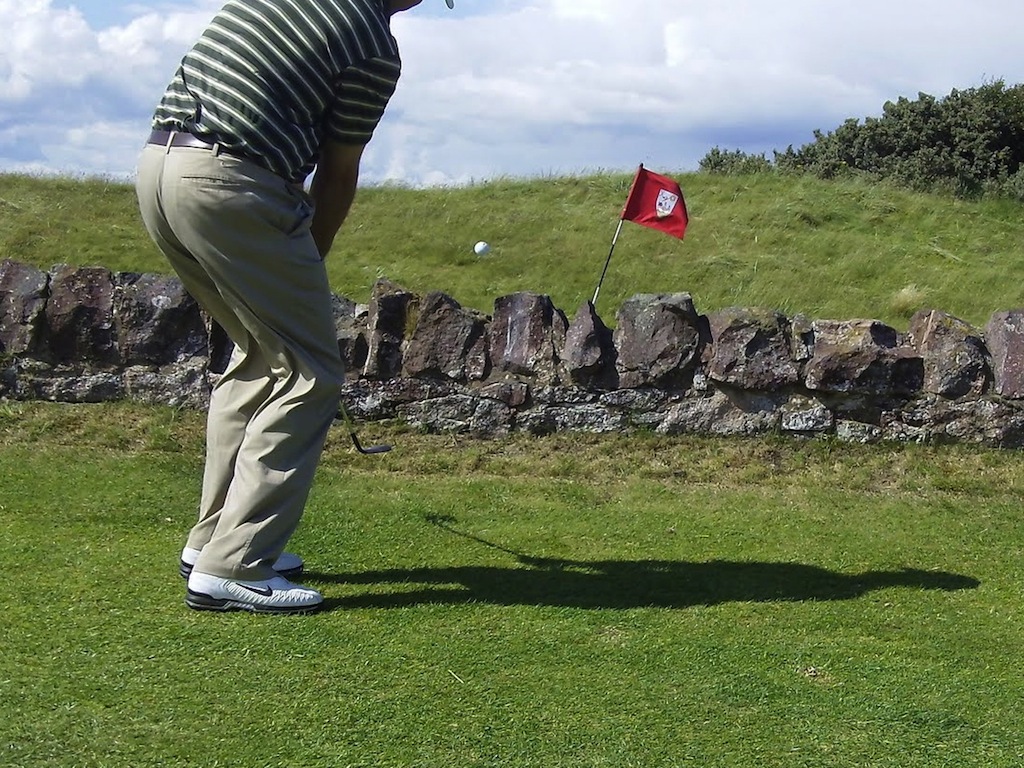
The short game yips are a plague to scorecards everywhere. This special form of yip happens to golfers who have no problem with their full swing or putting stroke, yet get performance anxiety around the greens. This leads to frustrating chips and pitches — skulls, chunks, shanks or even a complete inability to take the club back.
I see it all the time with my students, and even some tour players. Whether it’s an issue with technique or a mental block, the short game yips one of the hardest faults to overcome.
The process of getting over the yips may be embarrassing, but accepting your problem and working to improve is the only solution.
The following are my go-to drills to help someone improve their short-game technique, help them transfer it to the course and beat their short game yips forever.
Note: After studying a variety of 3D motion graphs from players of all skill levels, there are other items to look at when diagnosing a short-game problem, but these are the areas most commonly affected.
Swinging the club on plane
Plane is the first thing that I look at with my players who are struggling with their short game.
Most golfers know that they need to swing the club on plane during a full swing, but they forget about this in the short game, mainly because the swing is so short. The yips are caused by a manipulation of the club head that the body feels it needs to make to hit a solid shot. If the club is traveling on plane, then the club will return to the golf ball without needing any manipulation.
In most cases, I see the golf club swing under plane, which causes it to bottom out too soon behind the ball. That leads to chunks and bladed shots.
Below is an example of a good pitching motion from 30 yards where the club swings naturally on plane.
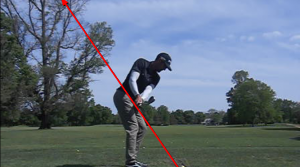
The club has started back nicely on plane. The golfer will hinge the club from here for a 30-yard pitch.
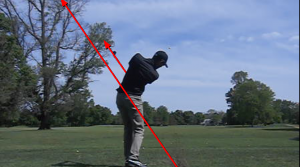
The golfer then pivots his body nicely while allowing the club to swing freely through, which keeps it on plane.
The hands don’t have to lead
One of the first things golfers learn about hitting chips and pitches is that the hands must lead the clubhead into the shot. As a result, the club will have a descending blow into the golf ball, allowing for ball-first contact. When you apply this method of chipping, however, the margin for error becomes surprisingly small. You must return the club to the back of the ball precisely to achieve the desired result.
I prefer that my students master the ability to return the club head to the ball just like they had it set up at address. The student returns the club and hands to the same position they were in at address, meaning the club would be ahead or even with the hands.
This creates a wider swing arc at the bottom of your swing, both in front of and behind the ball, creating a bigger margin for error.
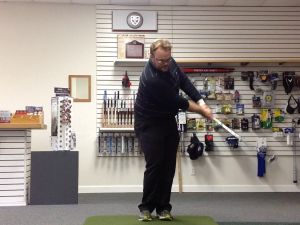
An example of the hands-leading method that requires manipulation and expert contact to be able to be successful.
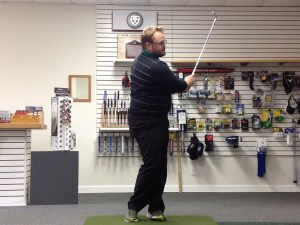
This method allows the club head to swing more freely through the ball, which means the club will pass the hands at some point in the swing and possibly before the ball on higher-lofted shots.
Of course, every yip is different, but swinging on plane and not forcing the hands to lead often produces the desired improvement.
Even when the yipper fixes the technical aspects in his short game, mental ramifications may still linger without some dedicated time practice drills. If you find yourself in that camp, try these two drills.
Drill 1: Short backswing, long follow through
When I teach golfers to let the club head swing through a short-game shot, most times they become timid about swinging the club with any speed. They instinctively try to control the club head by making a long backswing and swinging slowly through impact.
What I like to see is a backswing that stays low to the ground and doesn’t get past the right knee. From there, accelerate the club through to about a full finish, letting the club head swing through the ball and past the hands. Many golfers are amazed at how much speed they can generate with ease and how they can control the height and distance of the golf ball.
Drill 2: Short Game 21
You must simulate pressure in your practice to start to feel comfortable with any new technique, but especially your short game when trying to cure the yips.
Play this game with a friend, and pick a location around the chipping green. Each player will hit one shot from that spot and whoever is closest earns a point. If someone holes it, they earn 5 points. Rotate locations, and the goal is to be the first player to get 21 or more points.
You can alter the rules or scoring system to fit your desire or time constraints, but the point is to compete while trying to master your new technique. If you need more pressure, bet on who buys dinner to add some extra incentive.
The short game yips can be a mystery to many golfers and as a teacher there is no set agenda for helping someone improve this issue. But for me, the motions and drills above are a great place to start.
Drop your fear of the short game and learn to love it being around the greens again!
- LIKE69
- LEGIT35
- WOW3
- LOL0
- IDHT0
- FLOP3
- OB1
- SHANK20
Instruction
Clement: Laid-off or perfect fade? Across-the-line or perfect draw?

Some call the image on the left laid off, but if you are hitting a fade, this could be a perfect backswing for it! Same for across the line for a draw! Stop racking your brain with perceived mistakes and simply match backswing to shot shape!
- LIKE0
- LEGIT0
- WOW0
- LOL0
- IDHT0
- FLOP0
- OB0
- SHANK1
Instruction
The Wedge Guy: The easiest-to-learn golf basic

My golf learning began with this simple fact – if you don’t have a fundamentally sound hold on the golf club, it is practically impossible for your body to execute a fundamentally sound golf swing. I’m still a big believer that the golf swing is much easier to execute if you begin with the proper hold on the club.
As you might imagine, I come into contact with hundreds of golfers of all skill levels. And it is very rare to see a good player with a bad hold on the golf club. There are some exceptions, for sure, but they are very few and very far between, and they typically have beat so many balls with their poor grip that they’ve found a way to work around it.
The reality of biophysics is that the body moves only in certain ways – and the particulars of the way you hold the golf club can totally prevent a sound swing motion that allows the club to release properly through the impact zone. The wonderful thing is that anyone can learn how to put a fundamentally sound hold on the golf club, and you can practice it anywhere your hands are not otherwise engaged, like watching TV or just sitting and relaxing.
Whether you prefer an overlap, interlock or full-finger (not baseball!) grip on the club, the same fundamentals apply. Here are the major grip faults I see most often, in the order of the frequency:
Mis-aligned hands
By this I mean that the palms of the two hands are not parallel to each other. Too many golfers have a weak left hand and strong right, or vice versa. The easiest way to learn how to hold the club with your palms aligned properly is to grip a plain wooden ruler or yardstick. It forces the hands to align properly and shows you how that feels. If you grip and re-grip a yardstick several times, then grip a club, you’ll see that the learning curve is almost immediate.
The position of the grip in the upper/left hand
I also observe many golfers who have the butt of the grip too far into the heel pad of the upper hand (the left hand for right-handed players). It’s amazing how much easier it is to release the club through the ball if even 1/4-1/2″ of the butt is beyond the left heel pad. Try this yourself to see what I mean. Swing the club freely with just your left hand and notice the difference in its release from when you hold it at the end of the grip, versus gripping down even a half inch.
To help you really understand how this works, go to the range and hit shots with your five-iron gripped down a full inch to make the club the same length as your seven-iron. You will probably see an amazing shot shape difference, and likely not see as much distance loss as you would expect.
Too much lower (right) hand on the club
It seems like almost all golfers of 8-10 handicap or higher have the club too far into the palm of the lower hand, because that feels “good” if you are trying to control the path of the clubhead to the ball. But the golf swing is not an effort to hit at the ball – it is a swing of the club. The proper hold on the club has the grip underneath the pad at the base of the fingers. This will likely feel “weak” to you — like you cannot control the club like that. EXACTLY. You should not be trying to control the club with your lower/master hand.
Gripping too tightly
Nearly all golfers hold the club too tightly, which tenses up the forearms and prevents a proper release of the club through impact. In order for the club to move back and through properly, you must feel that the club is controlled by the last three fingers of the upper hand, and the middle two fingers of the lower hand. If you engage your thumbs and forefingers in “holding” the club, the result will almost always be a grip that is too tight. Try this for yourself. Hold the club in your upper hand only, and squeeze firmly with just the last three fingers, with the forefinger and thumb off the club entirely. You have good control, but your forearms are not tense. Then begin to squeeze down with your thumb and forefinger and observe the tensing of the entire forearm. This is the way we are made, so the key to preventing tenseness in the arms is to hold the club very lightly with the “pinchers” — the thumbs and forefingers.
So, those are what I believe are the four fundamentals of a good grip. Anyone can learn them in their home or office very quickly. There is no easier way to improve your ball striking consistency and add distance than giving more attention to the way you hold the golf club.
More from the Wedge Guy
- The Wedge Guy: Golf mastery begins with your wedge game
- The Wedge Guy: Why golf is 20 times harder than brain surgery
- The Wedge Guy: Musings on the golf ball rollback
- LIKE88
- LEGIT13
- WOW6
- LOL1
- IDHT0
- FLOP4
- OB1
- SHANK8
Instruction
Clement: Stop ripping off your swing with this drill!

Not the dreaded headcover under the armpit drill! As if your body is defective and can’t function by itself! Have you seen how incredible the human machine is with all the incredible feats of agility all kinds of athletes are accomplishing? You think your body is so defective (the good Lord is laughing his head off at you) that it needs a headcover tucked under the armpit so you can swing like T-Rex?
- LIKE0
- LEGIT2
- WOW2
- LOL0
- IDHT0
- FLOP0
- OB0
- SHANK2
-

 19th Hole3 weeks ago
19th Hole3 weeks agoDave Portnoy places monstrous outright bet for the 2024 Masters
-

 19th Hole1 week ago
19th Hole1 week agoJustin Thomas on the equipment choice of Scottie Scheffler that he thinks is ‘weird’
-

 19th Hole3 weeks ago
19th Hole3 weeks agoTiger Woods arrives at 2024 Masters equipped with a putter that may surprise you
-

 19th Hole7 days ago
19th Hole7 days ago‘Absolutely crazy’ – Major champ lays into Patrick Cantlay over his decision on final hole of RBC Heritage
-

 19th Hole2 weeks ago
19th Hole2 weeks agoTwo star names reportedly blanked Jon Rahm all week at the Masters
-

 19th Hole2 weeks ago
19th Hole2 weeks agoReport: LIV Golf identifies latest star name they hope to sign to breakaway tour
-

 19th Hole2 weeks ago
19th Hole2 weeks agoNeal Shipley presser ends in awkward fashion after reporter claims Tiger handed him note on 8th fairway
-

 19th Hole2 weeks ago
19th Hole2 weeks agoBrandel Chamblee has ‘no doubt’ who started the McIlroy/LIV rumor and why
















David
Feb 25, 2015 at 12:11 pm
Good info Scott. If you find yourself in the Chicago area definitely try to get a short game lesson from Scott. I had all sorts of issues with the short game and Scott used many of the above items to work through many of my problems. It’s always a work in process for me, but the week after my lesson I took home the trophy on a buddies trip mainly because I wasn’t leaking shots around the green. Thanks again Scott!
alan
Feb 16, 2015 at 3:59 pm
nevermind i see that it was north berwick. that and crail were my favorites
alan
Feb 16, 2015 at 3:58 pm
what that picture taken at north berwick golf club??
Lo
Feb 5, 2015 at 4:35 pm
You forgot tempo. I’ve had the chipping yips for years and now I’m (shivers) beginning to heal slowing down my tempo. I had gotten so scared that I didn’t realize I was swinging the club lightning fast playing my chips; now I only focus on swinging the club in slow motion and my game around the greens is finally getting better.
Dave reid
Jan 31, 2015 at 4:17 am
Yes….that is north berwick….
Chuck
Jan 30, 2015 at 8:56 pm
I’ve played St. Andrews (Old), Muirfield and Carnoustie. As well as Prestwick, Troon and Turnberry. The list of those I still want to play is long, and North Berwick is at the top.
Scott Hogan
Jan 30, 2015 at 8:01 pm
Hey guys, thanks for the comments and glad the article helped. I recently launched my remote coaching and to kick it off, if you want some help for free send me an email and I’ll let you know how to send me a video! Email is [email protected].
Bwood01
Jan 30, 2015 at 10:56 am
(sorry for the duplicate posts – it took a while for them to go through…)
Bwood01
Jan 30, 2015 at 10:55 am
Cont… I have to hit bump and runs from everywhere around the greens because of the yips. I also like the hybrid/ wood bump and run over putting from off the greens. These are my ‘go to’ shots. What’s really odd here is that I am a good bunker player – probably because it requires fuller swings at times.
Double Mocha Man
Jan 30, 2015 at 12:44 pm
Bwood01, you are a good bunker player because you can hit that shot “fat” and be screamingly successful.
Bwood01
Jan 30, 2015 at 10:53 am
Thanks for the information. This read was helpful for me. I have the chipping and pitching yips and they can ruin the possibility of a great score quickly.
Bwood01
Jan 30, 2015 at 10:48 am
Thanks for the information. This read was helpful for me… I have always been a good ball striker/ putter and I have won 15 amateur type tournaments since 2009… However; I have the chipping and pitching yips and for those of you that don’t, be glad of this. I would have won several more events if only I could pitch and chip… I have had a few lessons to get fixed, but always find myself going right back to my old habits. Because of this, I have to hit bump and runs from everywhere around the greens. I also like the hybrid/ wood bump and run over putting from off the greens. These are my ‘go to’ shots. What’s really odd here is that I am a good bunker player – probably because it requires fuller swings at times. When I put any ‘lofted club’ in my hands from off the green in grass, look out. My hands hinge quickly on the takeaway and I get too steep. I have tried everything from different bounce and grind options and various techniques like dead hands, forward press, hinge and hold – and nothing fixes it. The swing plane is likely my fault here – I get inside to quickly and steep. Guess I will have to get some video of me down the line to investigate further. Feel free to send suggestions/ thoughts to: [email protected] as it would be appreciated! watching videos help, but putting in to application is the tough part.
Chuck
Jan 30, 2015 at 10:45 am
Dear GolfWRX,
Can someone please tell me the source of the photograph that leads off this story? Specifically, what course is that? Is it the West Links at North Berwick? That golf course is #1 on my bucket list.
Chuck